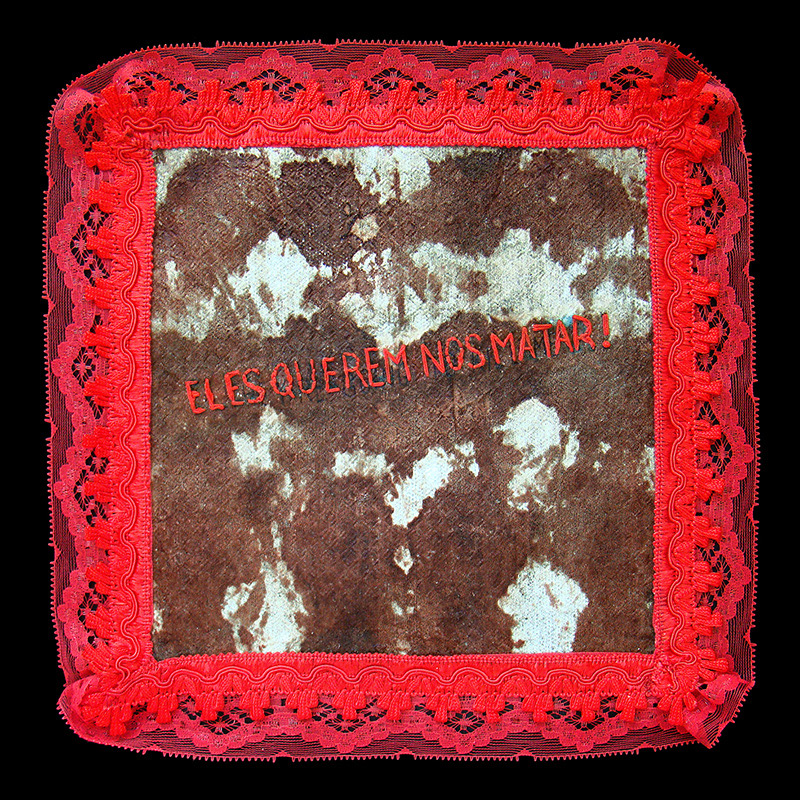Artists from Latin America explore embroidery quite innovatively and freely nowadays. They test this medium by stretching the limits of its employment and by experimenting with different materials used to stitch and apply on. They research the vernacular and habitual fields and methods of its usage to continue, manipulate, transcend, or subvert them. As a result, they demonstrate that embroidery, a demanding technique with a long history and multitude of cultural and social connotations, still offers fascinating and powerfully evocative visual language suitable to speak about various issues.
Embroidery is chosen today by male and female artists, self-taught and academically trained, across the region. They often have very different motivations and reasons for picking it up in their practice. Some are intrigued and driven towards it because of its traditional aspects, links to gendered social practices, luxury and decorative facets as well as folk and indigenous craft. Others are interested in the physical dimensions of threads and materials that are stitched. They investigate the fibres and textiles to make a conscious and aesthetic decision about what they work with. Few substitute conventional threads with metal and plastic wires or textiles with paper and rocks. The majority of them underline that embroidery requires time, focus, and planning, as it involves long hours of solitary work that helps in meditation, self-exploration, and outer-world contemplation. This process is an important part of the aesthetic they go for. Few who rely on artisan or indigenous traditions take the opposite route, and they prefer a collective approach that also has a performative aspect in itself.
In effect, embroidered works from Latin America can be seen today as small-scale, handy independent pieces or large, site-specific soft sculptures, installations, or registered and participatory performances. They are exhibited in prestigious regional and global institutions such as Tate Modern, MOMA, Guggenheim, and MALBA are on sale at international art fairs like Frieze, Art Basel Miami, or Armory Show. Though this technique previously was perceived as feminine, decorative, or crafty and as such was frequently displayed in ethnographic or design institutions, it is now treated as a multifaceted and mouldable instrument of communication used by contemporary artists who want to speak about the ecology, gender-based violence, costs of neoliberalism, the emancipation of minorities, LGBT communities and rights.
Old connotations and new applications
Embroidery is as old as human civilisation. Archaeologists found fossilised remains of hand-stitched decorated clothing that are dated to 30 000 BC. Its earliest traces were found in Asia, the Middle East and Scandinavia. In Latin America, the oldest embroidered textiles were discovered in Southern Peru, in burial chambers of the Paracas Culture (c.700 B.C.E- 200 C.E).
Historically and irrespectively of different cultures, this technique was used to embellish and raise the value of textiles. Materials decorated this way were treated as luxury items, splendid and sumptuous. In consequence, they were reserved for special occasions and religious or state rituals. Church hierarchy, nobility, royal courtiers and kings, queens wear embroidered clothing. Their expensive value was related to the labour, skill, time, fibres, and threads needed to produce them.
(...)
During the COVID-19 pandemic, a Brazilian artist Fábio Carvalho, referred to a similar abject aesthetic in an art piece Necropolítica Nacional (ELES QUEREM NOS MATAR!)/National Necropolitics (THEY WANT TO KILL US!). He embroidered a message on a tissue soaked in his blood, which was also decorated with red lace.The artist reflected on the new way of living in quarantine; the seclusion, isolation, and the immense fear of another human being. Carvalho explored the emotions created by the new restrictions, when the borders were reduced to our homes, our skin, and the respiratory masks that promised to separate us from the disease. By adding lace and embroidery he aimed to transform anguish, horror, fear, and anxiety, into something that could give us some purpose. This transformation of the horrific, appalling material with care, attention to detail, vibrant red ornament around the fabric perimeter suggests agency even in the hardest times.
|
